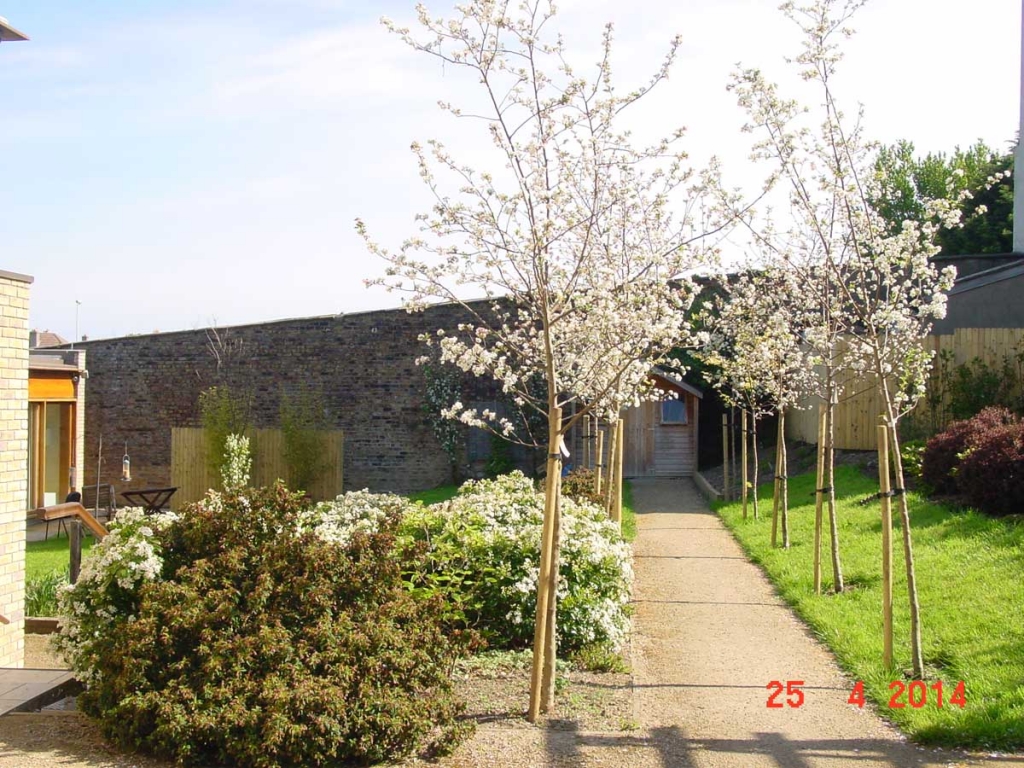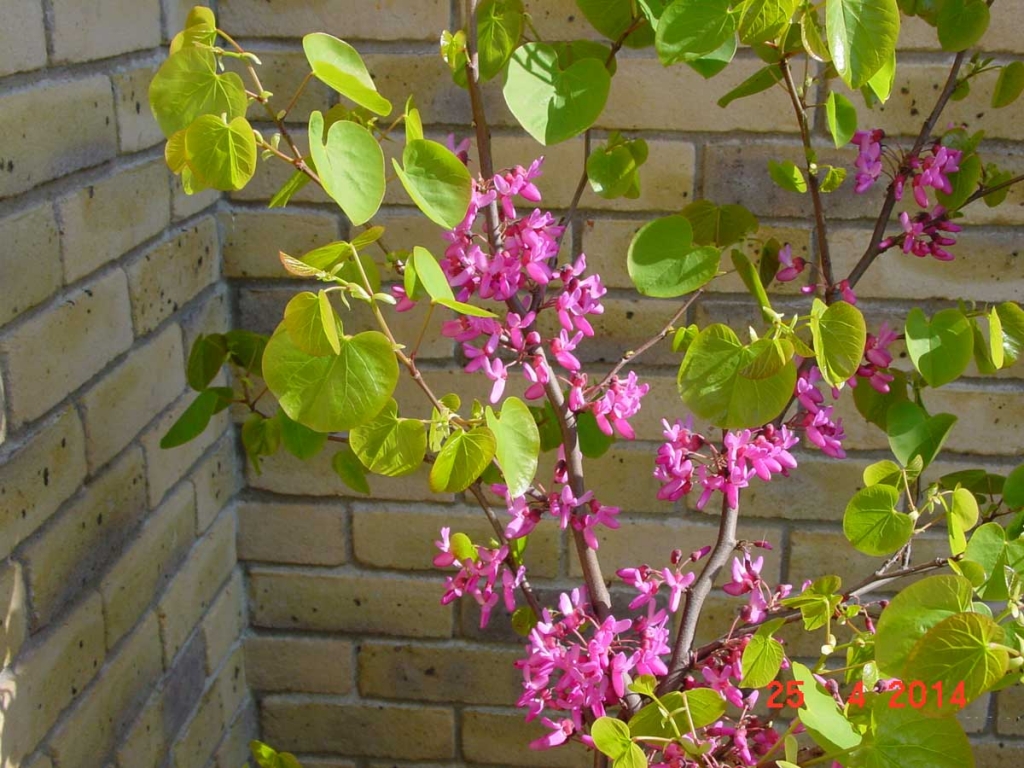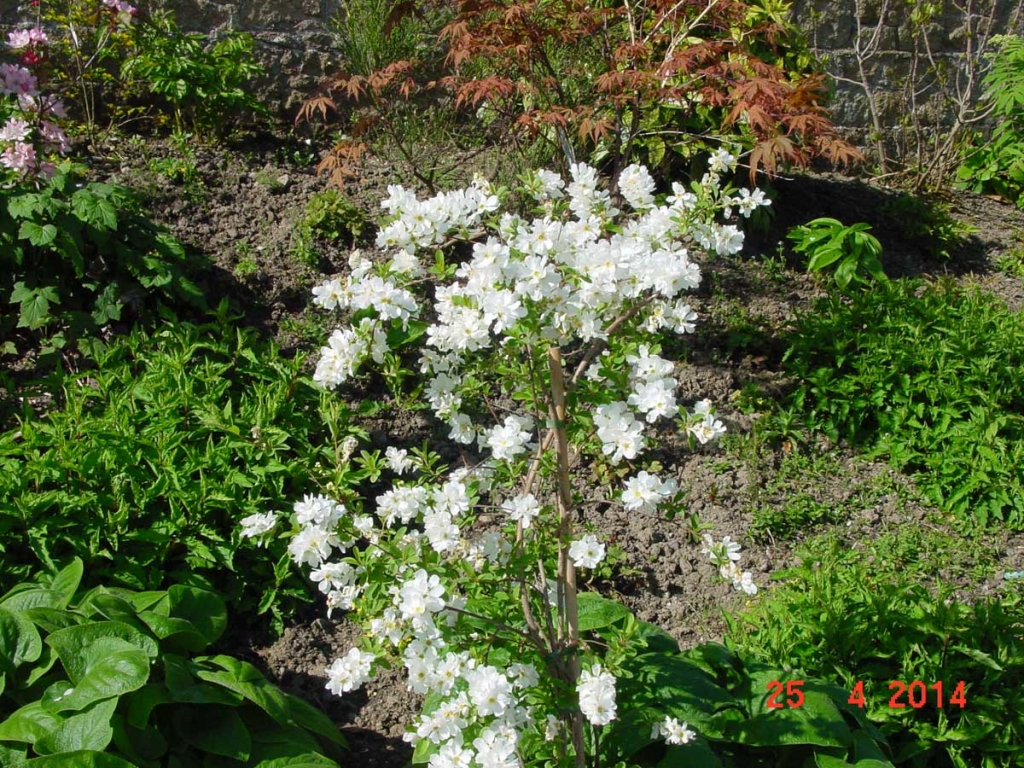Almost 5 years on, since I became involved in this garden project, it is certainly heart-warming to see the results of planning, planting, patience and dedicated hard work. Of course, while Mother Nature is in control with regard to growth and development of plants, none can dispute the amount of regular dedicated work of volunteer gardeners, from the Foxrock & District Garden Club & elsewhere, who did and continue to do the digging, weeding, pruning, cutting back, mulching, feeding and watering thus ensuring a healthy environment for all the residents in the Orchard garden. There were times when paid and unpaid help from strong young men was necessary to deal with demanding and difficult labour intensive jobs. Furthermore, thanks to generous sponsors of various projects the garden now boasts:
Harry Glendenning Tree walk.
Malus ‘Evereste’
Malus ‘Evereste’ is a conical tree with dark green, often lobed leaves. The flowers are freely borne, 5cm (2in) across, red in bud but open white. It is an excellent tree for spring blossom and autumnal red-orange-yellow fruit. A slow growing tree it grows to a height of 7m (22ft), and spread of 6m (20ft).
 Malus ‘Evereste’ is in flower right now – April
Malus ‘Evereste’ is in flower right now – April
Herbaceous walk of hand crafted wrought iron arches
There are four arches made and erected by Foleys Forge, Dunshaughlin, County Meath. Climbing plants were carefully selected to avoid any injuries or accidents, safety of the clients of Day Care & Respite Centre being paramount. Therefore, early, midseason and late flowering clematis imported from a specialist nursery in Amsterdam were planted during April. Roses and clematis are well-known excellent companion plants. However, choice of thorn and disease -free climbing roses being limited shrub roses such as ‘Buff Beauty’ and ‘Cornelia’ were planted to clothe the base of the arches. Clematis ‘Francis Rivis’, ‘Perle d’Azur’, ‘Justa’, ‘East River’, ‘Propertius’ and ‘Columella’ ought to do well. It takes from 3 to 5 years for clematis to ‘creep, crawl and leap’ so to say. There we go, have to exercise patience. Most tedious task is to keep an eye on the snails and slugs exercising their rasping tongues on new shoots emerging from beneath the soil. In fact, these molluscs feed on all parts of clematis plants. We can only try, and be vigilant. Recently hundreds of snails hibernating on the available spaces between the wooden posts of the long pergola were removed – loathe the very thought of all the damage they could have caused to many plants coming into spring growth.
Specially designed hand crafted wrought iron obelisks
Three obelisks also made and erected by Foleys Forge placed equidistantly along the wide herbaceous border play support to climbing annual sweet peas and clematis. The clematis plants fall into pruning group 3 – that is, their stems can be pruned back to about 30 cm (12 in) during late winter – thus ensuring no difficulty or fear of losing clematis when dead growths of sweet peas have to be removed around the same time as pruning of clematis.
Handcrafted wrought iron trellises on walls
Four trellises, of different sizes, were erected on the old and new walls. Plants such as Rosa banksia ‘Alba’, Wisteria sinensis, Clematis ‘Freda’, and Correa reflexa will clothe the trellises as they grow away.
The generously sponsored wrought iron structures were chosen for their durability and low maintenance over long period.
Sloping bed at the far end of the garden near the shed
Originally, this bed was planted with Alchemilla mollis (Lady’s mantle). While the yellow flowers and grey leaves looked okay for a short period during spring, the bed needed to be tidied up and replanted for summer interest. A couple of durable railway sleepers enabled the bank of soil to be held in place. Emer Torpey planted this bed, which benefits from evening sunshine with Ceanothus thyrsiflorus var. repens and white Flower Carpet roses. Lonicera crassifolia – a prostrate honeysuckle planted against the boundary fence at the back of this bed should add extra interest when a profusion of cream coloured flowers with hints of pink appears during late spring to early summer months. This relatively new Chinese evergreen plant propagated in Wexford rarely reaches more than 7.5 cm (3in) in height spreading to about 1 m (3 ft) in as many years. By all accounts an excellent ground cover plant. The species name crassifolia implies foliage is dense, with small, shiny, thick and succulent, rounded leaves.
Notes on some early (April – May) flowering trees, shrubs and climbers
Dry and warm summer of 2013 has certainly helped early spring flowering trees and shrubs to ripen their flowering wood and produce their very best flowers this spring. That dry summer in spite of our efforts to water the plants as often as it was possible also resulted in a good few losses. However, happy to report on those plants which survived that long dry summer to flower profusely this April:
Cercis siliquastrum ‘Bodnant’: An early flowering small tree, also known as Judas Tree, native to the Eastern Mediterranean region, planted in a sheltered corner of the sensory garden has masses of vivid dark purple/ pink flowers ahead of time (usual flowering time May) – thanks to higher than normal spring temperatures.

Cercis siliquastrum

Exochorda macrantha
Exochorda macrantha ‘The Bride’ also known as Pearl Bush ‘The Bride’ is a large arching shrub. This young plant is covered in pure white flowers.
Magnolia stellata and Prunus glandulosa ‘Alba’ (Chinese Bush Cherry) carefully transplanted from my garden in autumn 2012 settled down comfortably and are showing off their single and double white flowers respectively.
Pieris japonica ‘Little Heath’ another transplanted resident is at its very best right now.
Climbers such as Clematis ‘Tsunami Child’, ‘Francis Rivis’, ‘Propertius’, and Wisteria sinensis are either in flower or their buds are unfolding to show off their flowers.
Finally, my five-star award goes to Rosemary plants – both prostrate & upright -in the garden. They flowered their hearts out all through the winter months and a few are in flower right now.
Time is fast approaching to enjoy the darling buds of May!
Mary Toomey, 21st April 2014
